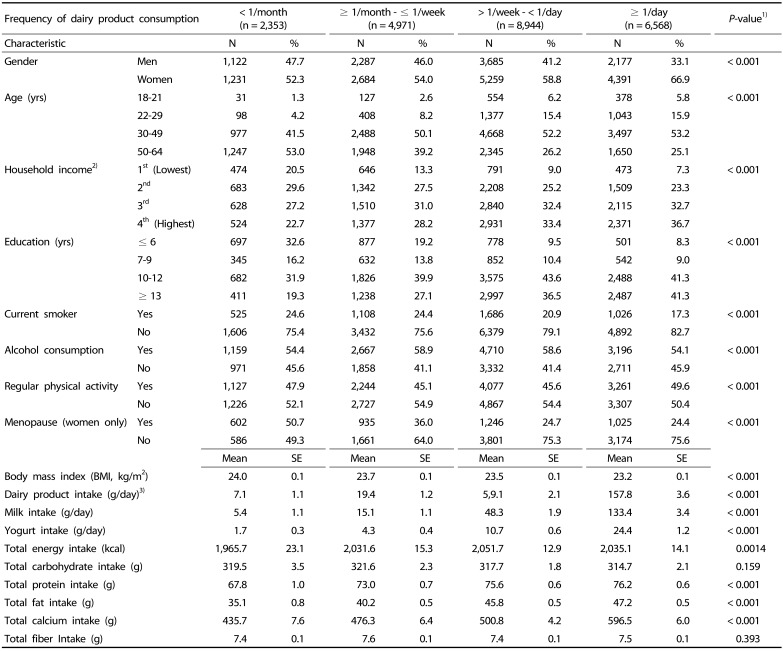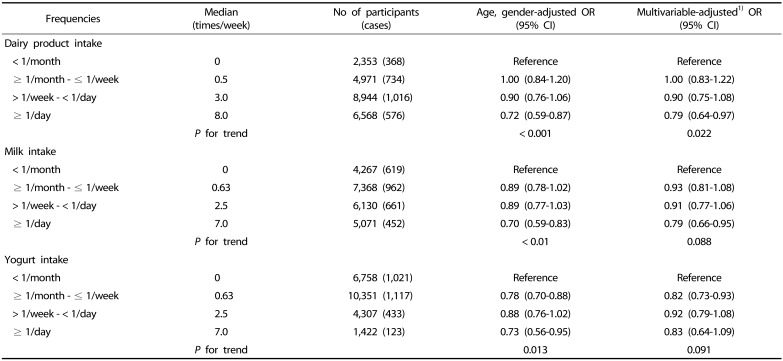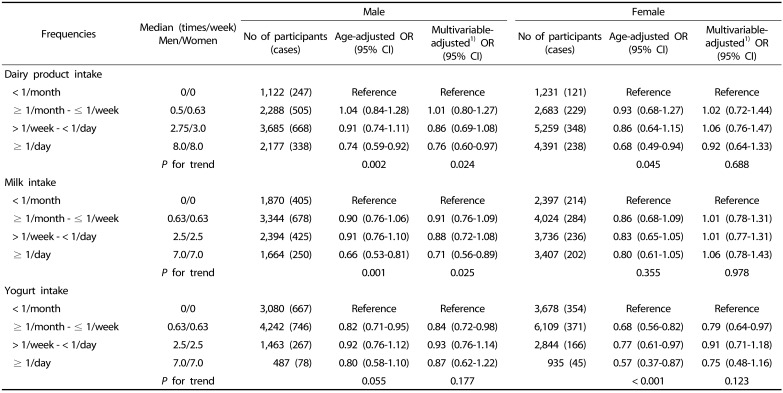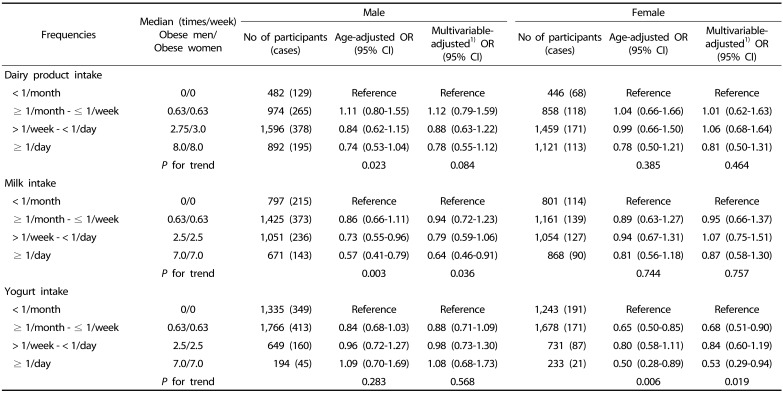1. Iglseder B, Cip P, Malaimare L, Ladurner G, Paulweber B. The metabolic syndrome is a stronger risk factor for early carotid atherosclerosis in women than in men. Stroke. 2005; 36:1212–1217. PMID:
15890992.

2. Khaliq A, Johnson BD, Anderson RD, Bavry AA, Cooper-DeHoff RM, Handberg EM, Bairey Merz CN, Nicholls SJ, Nissen S, Pepine CJ. Relationships between components of metabolic syndrome and coronary intravascular ultrasound atherosclerosis measures in women without obstructive coronary artery disease: the NHLBISponsored Women's Ischemia Syndrome Evaluation Study. Cardiovasc Endocrinol. 2015; 4:45–52. PMID:
26665010.
3. World Health Organizatino. Global Atlas on Cardiovascular Disease Prevention and Control: Policies, Strategies and Interventions. Geneva: World Health Organization;2011.
5. Miller M, Stone NJ, Ballantyne C, Bittner V, Criqui MH, Ginsberg HN, Goldberg AC, Howard WJ, Jacobson MS, Kris-Etherton PM, Lennie TA, Levi M, Mazzone T, Pennathur S. American Heart Association Clinical Lipidology, Thrombosis, and Prevention Committee of the Council on Nutrition, Physical Activity, and Metabolism. Council on Arteriosclerosis, Thrombosis and Vascular Biology. Council on Cardiovascular Nursing. Council on the Kidney in Cardiovascular Disease. Triglycerides and cardiovascular disease: a scientific statement from the American Heart Association. Circulation. 2011; 123:2292–2333. PMID:
21502576.
6. Berglund L, Brunzell JD, Goldberg AC, Goldberg IJ, Sacks F, Murad MH, Stalenhoef AF. Endocrine society. Evaluation and treatment of hypertriglyceridemia: an Endocrine Society clinical practice guideline. J Clin Endocrinol Metab. 2012; 97:2969–2989. PMID:
22962670.

7. Toth PP. Triglyceride-rich lipoproteins as a causal factor for cardiovascular disease. Vasc Health Risk Manag. 2016; 12:171–183. PMID:
27226718.

8. Ballantyne CM, Olsson AG, Cook TJ, Mercuri MF, Pedersen TR, Kjekshus J. Influence of low high-density lipoprotein cholesterol and elevated triglyceride on coronary heart disease events and response to simvastatin therapy in 4S. Circulation. 2001; 104:3046–3051. PMID:
11748098.

9. Miller M, Cannon CP, Murphy SA, Qin J, Ray KK, Braunwald E. PROVE IT-TIMI 22 Investigators. Impact of triglyceride levels beyond low-density lipoprotein cholesterol after acute coronary syndrome in the PROVE IT-TIMI 22 trial. J Am Coll Cardiol. 2008; 51:724–730. PMID:
18279736.

10. Faergeman O, Holme I, Fayyad R, Bhatia S, Grundy SM, Kastelein JJ, LaRosa JC, Larsen ML, Lindahl C, Olsson AG, Tikkanen MJ, Waters DD, Pedersen TR. Steering Committees of IDEAL and TNT Trials. Plasma triglycerides and cardiovascular events in the Treating to New Targets and Incremental Decrease in End-Points through Aggressive Lipid Lowering trials of statins in patients with coronary artery disease. Am J Cardiol. 2009; 104:459–463. PMID:
19660594.

11. Chen AH, Tseng CH. The role of triglyceride in cardiovascular disease in Asian patients with type 2 diabetes--a systematic review. Rev Diabet Stud. 2013; 10:101–109. PMID:
24380086.
12. Sone H, Tanaka S, Tanaka S, Iimuro S, Oida K, Yamasaki Y, Oikawa S, Ishibashi S, Katayama S, Ohashi Y, Akanuma Y, Yamada N. Japan Diabetes Complications Study Group. Serum level of triglycerides is a potent risk factor comparable to LDL cholesterol for coronary heart disease in Japanese patients with type 2 diabetes: subanalysis of the Japan Diabetes Complications Study (JDCS). J Clin Endocrinol Metab. 2011; 96:3448–3456. PMID:
21865372.

13. Tseng CH, Tseng CP, Chong CK, Cheng JC, Tai TY. Independent association between triglycerides and coronary artery disease in Taiwanese type 2 diabetic patients. Int J Cardiol. 2006; 111:80–85. PMID:
16213608.

14. Singh GM, Micha R, Khatibzadeh S, Shi P, Lim S, Andrews KG, Engell RE, Ezzati M, Mozaffarian D. Global Burden of Diseases Nutrition and Chronic Diseases Expert Group (NutriCoDE). NutriCoDE). Global, regional, and national consumption of sugar-sweetened beverages, fruit juices, and milk: a systematic assessment of beverage intake in 187 countries. PLoS One. 2015; 10:e0124845. PMID:
26244332.
15. Michaëlsson K, Wolk A, Langenskiöld S, Basu S, Warensjö Lemming E, Melhus H, Byberg L. Milk intake and risk of mortality and fractures in women and men: cohort studies. BMJ. 2014; 349:g6015. PMID:
25352269.

16. Korea Health Industry Development Institute. National food & nutrition statistics: based on 2017 Korea National Health and Nutrition Examination Survey [Internet]. Cheongju: Korea Health Industry Development Institute;2017. cited 2019 December 10. Available from:
https://www.khidi.or.kr/nutristat.
17. Mena-Sánchez G, Becerra-Tomás N, Babio N, Salas-Salvadó J. Dairy product consumption in the prevention of metabolic syndrome: a systematic review and meta-analysis of prospective cohort studies. Adv Nutr. 2019; 10:S144–S153. PMID:
31089736.

18. Alexander DD, Bylsma LC, Vargas AJ, Cohen SS, Doucette A, Mohamed M, Irvin SR, Miller PE, Watson H, Fryzek JP. Dairy consumption and CVD: a systematic review and meta-analysis. Br J Nutr. 2016; 115:737–750. PMID:
26786887.

19. Lovegrove JA, Givens DI. Dairy food products: good or bad for cardiometabolic disease. Nutr Res Rev. 2016; 29:249–267. PMID:
27666526.

20. Baxter AJ, Coyne T, McClintock C. Dietary patterns and metabolic syndrome--a review of epidemiologic evidence. Asia Pac J Clin Nutr. 2006; 15:134–142. PMID:
16672196.
21. de Goede J, Soedamah-Muthu SS, Pan A, Gijsbers L, Geleijnse JM. Dairy consumption and risk of stroke: a systematic review and updated dose-response meta-analysis of prospective cohort studies. J Am Heart Assoc. 2016; 5(5):

22. Pereira MA, Jacobs DR Jr, Van Horn L, Slattery ML, Kartashov AI, Ludwig DS. Dairy consumption, obesity, and the insulin resistance syndrome in young adults: the CARDIA Study. JAMA. 2002; 287:2081–2089. PMID:
11966382.

23. Lee HJ, Cho JI, Lee HS, Kim CI, Cho E. Intakes of dairy products and calcium and obesity in Korean adults: Korean National Health and Nutrition Examination Surveys (KNHANES) 2007-2009. PLoS One. 2014; 9:e99085. PMID:
24915202.

24. Moreno LA, Bel-Serrat S, Santaliestra-Pasías A, Bueno G. Dairy products, yogurt consumption, and cardiometabolic risk in children and adolescents. Nutr Rev. 2015; 73 Suppl 1:8–14. PMID:
26175484.

25. van Aerde MA, Soedamah-Muthu SS, Geleijnse JM, Snijder MB, Nijpels G, Stehouwer CD, Dekker JM. Dairy intake in relation to cardiovascular disease mortality and all-cause mortality: the Hoorn Study. Eur J Nutr. 2013; 52:609–616. PMID:
22555618.

26. Larsson SC, Männistö S, Virtanen MJ, Kontto J, Albanes D, Virtamo J. Dairy foods and risk of stroke. Epidemiology. 2009; 20:355–360. PMID:
19057387.

27. Kondo I, Ojima T, Nakamura M, Hayasaka S, Hozawa A, Saitoh S, Ohnishi H, Akasaka H, Hayakawa T, Murakami Y, Okuda N, Miura K, Okayama A, Ueshima H. NIPPON DATA80 Research Group. Consumption of dairy products and death from cardiovascular disease in the Japanese general population: the NIPPON DATA80. J Epidemiol. 2013; 23:47–54. PMID:
23208514.

28. Elwood PC, Pickering JE, Fehily AM. Milk and dairy consumption, diabetes and the metabolic syndrome: the Caerphilly prospective study. J Epidemiol Community Health. 2007; 61:695–698. PMID:
17630368.

29. Vergnaud AC, Péneau S, Chat-Yung S, Kesse E, Czernichow S, Galan P, Hercberg S, Bertrais S. Dairy consumption and 6-y changes in body weight and waist circumference in middle-aged French adults. Am J Clin Nutr. 2008; 88:1248–1255. PMID:
18996859.
30. Lee CJ, Joung H. Milk intake is associated with metabolic syndrome - using data from the Korea National Health and Nutrition Examination Survey 2007~2010. Korean J Community Nutr. 2012; 17:795–804.

31. Rice BH. Dairy and cardiovascular disease: a review of recent observational research. Curr Nutr Rep. 2014; 3:130–138. PMID:
24818071.

32. Ness AR, Smith GD, Hart C. Milk, coronary heart disease and mortality. J Epidemiol Community Health. 2001; 55:379–382. PMID:
11350992.

33. Shin H, Yoon YS, Lee Y, Kim CI, Oh SW. Dairy product intake is inversely associated with metabolic syndrome in Korean adults: Anseong and Ansan cohort of the Korean Genome and Epidemiology Study. J Korean Med Sci. 2013; 28:1482–1488. PMID:
24133353.

34. Kwon HT, Lee CM, Park JH, Ko JA, Seong EJ, Park MS, Cho B. Milk intake and its association with metabolic syndrome in Korean: analysis of the third Korea National Health and Nutrition Examination Survey (KNHANES III). J Korean Med Sci. 2010; 25:1473–1479. PMID:
20890429.

35. Moss M, Freed D. The cow and the coronary: epidemiology, biochemistry and immunology. Int J Cardiol. 2003; 87:203–216. PMID:
12559541.

36. Soedamah-Muthu SS, Ding EL, Al-Delaimy WK, Hu FB, Engberink MF, Willett WC, Geleijnse JM. Milk and dairy consumption and incidence of cardiovascular diseases and all-cause mortality: doseresponse meta-analysis of prospective cohort studies. Am J Clin Nutr. 2011; 93:158–171. PMID:
21068345.

37. Beydoun MA, Gary TL, Caballero BH, Lawrence RS, Cheskin LJ, Wang Y. Ethnic differences in dairy and related nutrient consumption among US adults and their association with obesity, central obesity, and the metabolic syndrome. Am J Clin Nutr. 2008; 87:1914–1925. PMID:
18541585.

38. Wennersberg MH, Smedman A, Turpeinen AM, Retterstøl K, Tengblad S, Lipre E, Aro A, Mutanen P, Seljeflot I, Basu S, Pedersen JI, Mutanen M, Vessby B. Dairy products and metabolic effects in overweight men and women: results from a 6-mo intervention study. Am J Clin Nutr. 2009; 90:960–968. PMID:
19710195.

39. Zemel MB, Thompson W, Milstead A, Morris K, Campbell P. Calcium and dairy acceleration of weight and fat loss during energy restriction in obese adults. Obes Res. 2004; 12:582–590. PMID:
15090625.

40. Faghih S, Abadi AR, Hedayati M, Kimiagar SM. Comparison of the effects of cows' milk, fortified soy milk, and calcium supplement on weight and fat loss in premenopausal overweight and obese women. Nutr Metab Cardiovasc Dis. 2011; 21:499–503. PMID:
20227261.

41. Teegarden D, White KM, Lyle RM, Zemel MB, Van Loan MD, Matkovic V, Craig BA, Schoeller DA. Calcium and dairy product modulation of lipid utilization and energy expenditure. Obesity (Silver Spring). 2008; 16:1566–1572. PMID:
18421269.

42. Boon N, Hul GB, Stegen JH, Sluijsmans WE, Valle C, Langin D, Viguerie N, Saris WH. An intervention study of the effects of calcium intake on faecal fat excretion, energy metabolism and adipose tissue mRNA expression of lipid-metabolism related proteins. Int J Obes (Lond). 2007; 31:1704–1712. PMID:
17579637.

43. Shin S, Lee HW, Kim CE, Lim J, Lee JK, Kang D. Association between milk consumption and metabolic syndrome among Korean Adults: results from the health examinees study. Nutrients. 2017; 9:E1102. PMID:
28991181.

44. Yoo JE, Jun JH, Kim SH, Lee JA, Park HS. Dietary patterns of hypertriglyceridemia among Koreans based on food frequency questionnaire. Korean J Fam Pract. 2016; 6:96–104.

45. Yang EJ, Chung HK, Kim WY, Kerver JM, Song WO. Carbohydrate intake is associated with diet quality and risk factors for cardiovascular disease in U.S. adults: NHANES III. J Am Coll Nutr. 2003; 22:71–79. PMID:
12569117.

46. Park SH, Lee KS, Park HY. Dietary carbohydrate intake is associated with cardiovascular disease risk in Korean: analysis of the third Korea National Health and Nutrition Examination Survey (KNHANES III). Int J Cardiol. 2010; 139:234–240. PMID:
19013653.

47. Lisko DJ, Johnston GP, Johnston CG. Effects of dietary yogurt on the healthy human gastrointestinal (GI) microbiome. Microorganisms. 2017; 5:E6. PMID:
28212267.

48. Suzuki Y, Ikeda K, Sakuma K, Kawai S, Sawaki K, Asahara T, Takahashi T, Tsuji H, Nomoto K, Nagpal R, Wang C, Nagata S, Yamashiro Y. Association between yogurt consumption and intestinal microbiota in healthy young adults differs by host gender. Front Microbiol. 2017; 8:847. PMID:
28553274.

49. Matey-Hernandez ML, Williams FM, Potter T, Valdes AM, Spector TD, Menni C. Genetic and microbiome influence on lipid metabolism and dyslipidemia. Physiol Genomics. 2018; 50:117–126. PMID:
29341867.









 PDF
PDF ePub
ePub Citation
Citation Print
Print



 XML Download
XML Download